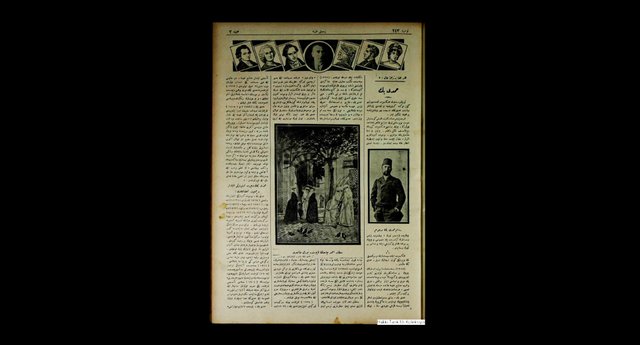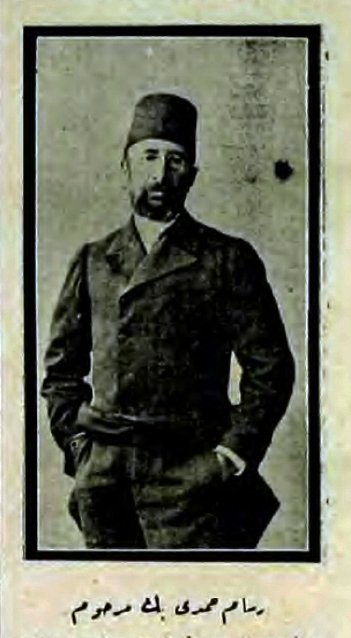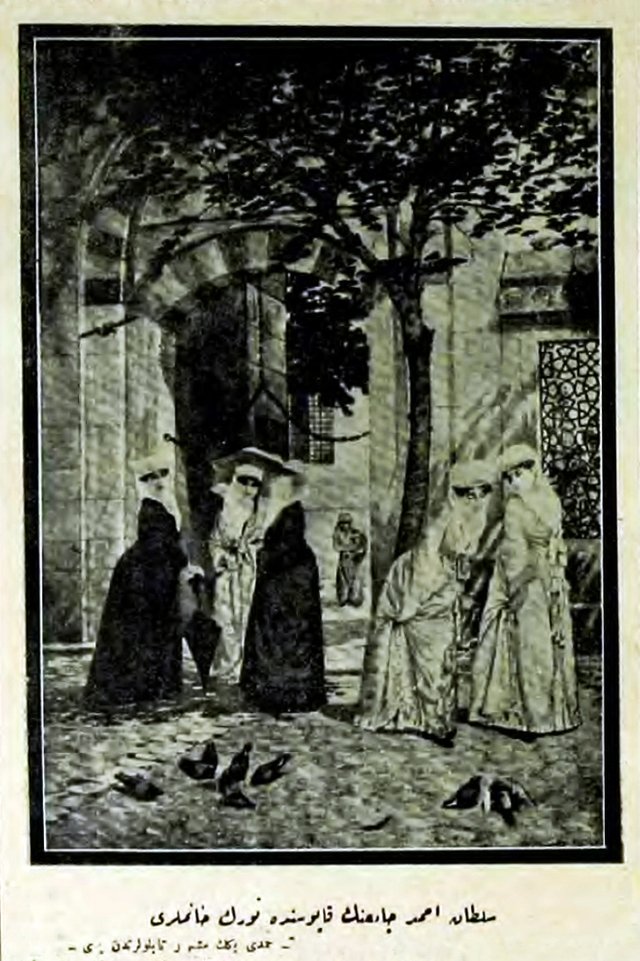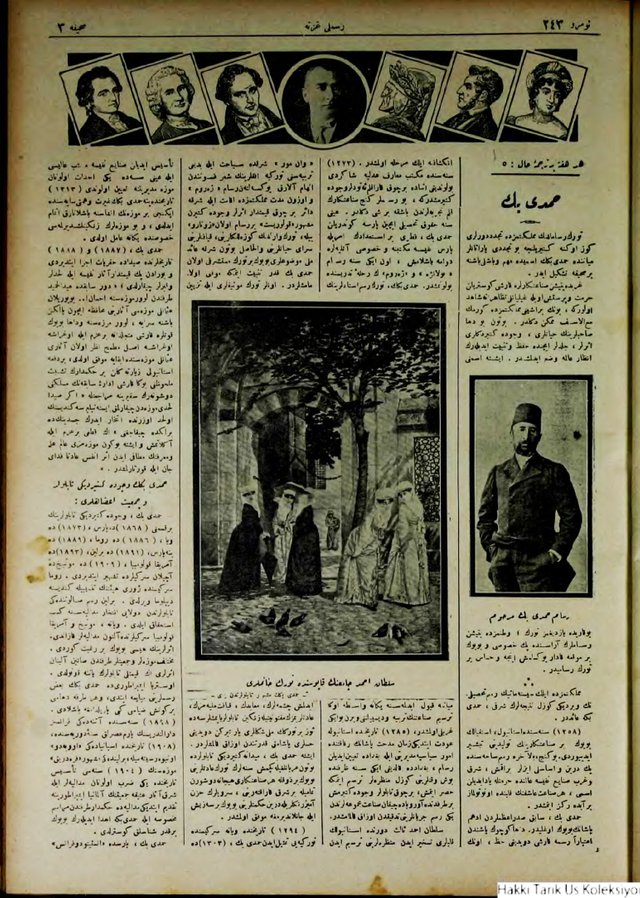181. Today in 1920s Turkey: 28 April 1928 (The Famous Ottoman Painter, Osman Hamdi Bey)

(Article by Nurettin İbrahim, Resimli Gazete or “The Illustrated Gazette,” 28 April 1928, no. 243, page 3.)
Introduction to the Text and Comments:
In 1928 the illustrated journal Resimli Gazete ran a weekly series called “One Biography Every Week” (Her Hafta Bir Tercüme-yi Hal) and included articles on famous historical figures such as Julius Caesar, Bernard Shaw, and Richard Wagner. The series is visually announced with a masthead illustration arranging the portraits of seven famous men at the top of the page—the central picture belonging to Turkey’s first president Mustafa Kemal (Atatürk).

This biographical article on Osman Hamdi Bey (1842-1910) by Nurettin İbrahim is the fifth installment in the series. The most famous painter of the late Ottoman period, Osman Hamdi was a modern Renaissance man: he was an artist, teacher, curator, archaeologist, scholar, and lawmaker. The article, which includes a portrait photograph of Osman Hamdi and a reproduction of one of his paintings, outlines the significance of this figure in the greater history of Turkish art. The article was originally published in Ottoman Turkish. In addition to including images of the original text (thanks to the digitized Hakkı Tarık Us Collection) this post includes the modern Turkish transcription and my English translation of the article below.
This essay demonstrates how quickly modern Turkish (art) historiography elevated Osman Hamdi into its pantheon of great artists, and for good reason. The first third of the article takes us from Hamdi Bey’s birth to his voyage to Ottoman Baghdad (age 27) which he made upon his return from studying painting in Paris for twelve years. The article provides a number of interesting details that aid in contextualizing how art was consumed and perceived during the lifetime of Osman Hamdi through the 1920s. For instance, by relaying that Hamdi Bey kept current with European artistic trends by flipping through illustrated magazines the author transports us to an era where print media is being consumed across a continent, albeit largely by members of the educated upper-classes such as Osman Hamdi Bey. We are also exposed to standards within the art scene of 1928: the author claims that art history books are filled with the names and accomplishments of Western geniuses, thus affording us a view into the types of art-related didactic materials that were available to an educated audience in Turkey.

(Caption: "Painter Hamdi Bey, deceased.")
The essay continues on to consider Osman Hamdi’s professional life as painter, archaeologist, and museum director. It portrays Hamdi Bey as an Orientalist insider, whose non-European perspective secured a degree of authenticity in representing the East unmatched in even the most well-traveled, Western-trained artists. As proof, the author points to a number of well-known Orientalist artists who spent time in the Ottoman Empire and were inspired by the alien atmosphere. Orientalism has always suffered from an authenticity deficit created by the “outsider’s gaze” which systematically objectified the East in paintings intended for European audiences. As a “Turk” with a unique perspective among his otherwise European peers, Hamdi Bey, offered an enhanced, and thus superior window into the true essence of the East. However, this “identity” of Osman Hamdi is only partially true. As an Ottoman subject who lived in Istanbul he could indeed be considered an “insider” to the so-called Orient, but a “Turk” in ethnicity he was not. Hamdi Bey, like many living in the cosmopolitan city of Istanbul at the turn of the previous century, was actually of Greek descent. Over the course of the 20th century (and apparently as early as the 1920s), Turkish nationalist historiography claimed Osman Hamdi as a great Turkish intellectual. And why would they not? Any race or state would be proud to have such a talented and passionate individual to be considered an outstanding member of their community.
The article also highlights the upward battle Hamdi Bey faced as an archaeologist and museum director. He worked during the reign of Abdülhamid II (r. 1876-1909), a sultan who had a propensity to give away or “gift” artworks and artifacts that were found in his territories to European rulers and institutions in return for various favors. Hamdi Bey’s appointment to the directorship of the Imperial Museum came at a time when archaeology was experiencing a boom and European collectors, entrepreneurs, and museums were flocking to Ottoman lands to profit from the “riches” and remove them from an Ottoman state too weak to enforce stricter antiquities laws. In this regard, Hamdi Bey’s incomplete law degree came in handy when he personally drafted newer, better antiquities laws as an administrator with the museum. Thus, he is also celebrated as a protector of the state’s cultural heritage; one who, according to the anecdote conveyed in the below essay, was not above putting his own life on the line to save a work of art from being lost to the Louvre.
The last third of the article bears the subtitle “The Paintings that Hamdi Bey Created and His Memberships in Associations.” Here we are introduced to the various museums and archaeological institutes that have either displayed or purchased Osman Hamdi’s works or included him as a member of their associations. This section presents a man with internationally-recognized expertise in his profession and field. According to this account, our artist is not only a talented painter whose work is recognized at the highest levels of the global art scene, but he is also an all-around art ambassador who has brushed shoulders with world leaders and an active participant in the academic study and institutional management of art works and archaeological artifacts.

(Caption:"Turkish Ladies at the Doors of the Sultanahmet Mosque, one of Hamdi Bey's famous paintings.")
Despite the subtitle’s claim, the text allotted little space to discussing any actual works of art from the painter’s oeuvre. The only work mentioned by name in all three parts of the text is in the caption included for the sample painting reproduced in the article. The article provides no other tombstone information for the work (which collection is it in? when was it made?). Are we to presume that this was one of the works that was purchased by a museum or emperor as narrated in the article? Why was this painting chosen and not any other one? Because there is no discussion of the painting itself in the article, we are left to merely speculate.
Many parts of histories and narratives are constructed and as such, they are subject to change with time. Indeed, today the above painting is not considered Hamdi Bey’s greatest or most popular work of art. Today Osman Hamdi’s name is almost synonymous with his painting, The Tortoise Trainer or Kaplumbağa Terbiyecisi (1906) which made headlines in 2004 when it sold for $3.5 million—the greatest amount a Turkish painting has ever fetched— in a bidding war between Istanbul Modern and the Pera Museum’s Suna and İnan Kıraç Foundation. Istanbul’s Pera Museum ultimately won out, and for now, the painting is by far the most popular and well-known work in the museum’s collection.

(Article by Nurettin İbrahim, Resimli Gazete or “The Illustrated Gazette,” 28 April 1928, no. 243, page 3. Hakkı Tarık Us Collection, Beyazıt State Library, Istanbul.)
Türkçe
Hamdi Bey
Türk ressamlığın memleketimizde teceddüt devirleri göz önüne getirilince bu teceddüdü yaratanlar miyanında Hamdi Bey’in ismi de mühim ve başlı başına bir sahife teşkil eder.
Garpta yetişen sanaatkarlara karşı gösterilen hürmet ve prestij öyle galeyanlı tezahürata şahit olur ki, bunun bir eşini memleketimizde görmek maalesef mümkün değildir. Bütün bu deha sahiplerinin hayatları, vücuda getirdikleri eserler, ciltler içinde hıfz ve tenbit edilerek enzar-ı aleme vazı edilmiştir. İşte ismi bu karide yazdığımız Türk; vatanımızda yetişen ressamların arasında pek hususi ve büyük bir mevkii kadar yükselmiş ince ve hassas Türk ressamıdır.
Memleketimizde ilk sistematik resim tahsilinin verdiği güzel neticelerin şerefi, Hamdi Bey’e aittir.
1258 senesinde İstanbul, istikbalin büyük bir sanatkarının tevlidini tebşir ediyordu. Bu genç, bilahara resim sahasında pek derin ve esaslı izler bırakmış, şark ve garp sanayi nefise aleminde hürmetle yad edilen ismi, her sanat aşığının kalbinde unutulmaz bir abide rekz etmiştir.
Hamdi Bey, sabık sadrazamlardan Ethem Paşa’nın büyük oğludur. Daha küçük yaşından itibaren resme karşı duyduğu haz, onun inkişafa ilk merhale olmuştur. 1273 senesinde mekteb-i Maarif Adliye şakirdi bulunduğu esnada birçok karakalem etüdler vücuda getirmiştir ki, bu resimler genç sanatkarın kalem tecrübelerinden başka bir şey değildir. Aynı sene hukuk tahsili için Paris’e gönderilen Hamdi Bey, fıtri bir ustadın emriyle Paris Nefise Mektebi’ne ve hususi atölyelere devama başlamış, on iki sene ressam “Bulanje” ve “Jerom”un rahle-yi tedrisinde bulunmuştur. Hamdi Bey’in, Türk resim ustadlarının miyanına kabul edilmesine yegane vasıta ona tersim sanaatının terbiye ve disiplinini veren bu iki garplı olmuştur. 1285 tarihinde İstanbul’a ivdet ettiği zaman Mithat Paşa’nın refakatında umur-ı siyasiye müdüriyeti ile Bağdat’a tayyin edilen ressam, Bağdat’ta kaldığı iki sene zarfında boş vakitlerini güzel manzaralar tersim etmeğe hasr etmiş, birçok tablolar vücuda getirmiş bir taraftan da Avrupa’da çıkan sanat mecmualarından yeni resim ceryanlarını tedkikten uzak kalmamıştır.
Sultan Ahmet salis devrinde İstanbul’un kalpleri teshir eden manzaralarını tersim eden “Vanmor,” şarkta seyahat ile bediyi terbiyesini Türkiye afaklarının şair füsunundan ilham alarak yükselten ressam “Jerom,” ve uzun müddet memleketimizde ikamet ile şarka dair birçok kısmetdar eserler vücuda getiren meşhur “Kolorist” bir ressam olan “Zonaro” bile, Türk varlığın güzelliklerini, kıyafetlerini, saray hayatlarını velhasıl bütün şarka ait milli mevzuları büyük bir Türk müsteşriki olan Hamdi Bey kadar tespit etmeye mevki olamamışlardır. Onlar Türk motifleri ile tezyin edilmiş çeşmelerin, [معایدک], kıyafet-i milliyemizin, adetlerimizin meftuniyetile zengin tablolar yapmışlarsa da öz bir Türk’ün milli şekilleri yaratırken duyduğu hisleri yaşamak kudretinden uzak kalmışlardır. İşte Hamdi Bey, meydana getirdiği tablolarda bütün urbanlığıyla geçmiş senelerin Türk adetlerini büyük bir zevkle her sanatkarı heyecana düşüren tamamıyla bir şark karakterini, servilerin hazin amiz renkleriyle derin hikmetlerini büyük bir seziş ile canlandırmağa muvaffak olmuştur.
1294 tarihinde Viyana sergisinde Türkiye’yi temsil eden Hamdi Bey, 1302’de te’sis edilen Sanayi-yi Nefise Mekteb-i Alisi ile aynı senede yeni ihdat olunan müze müdüriyetine tayin olundu. 1313 tarihinde yine Hamdi Bey’in gayret ve himmeti sayesinde ikinci bir müzenin inşaasına başlanarak itmam edildi, ve bu müzelerin zenginleştirilmesi hususunda yegane amel oldu.
Hamdi Bey, 1887 ve 1888 tarihlerinde Sayda’da hafriyat icra ettirdiği ve buradan pek kıymetdar eser-i nefise ile lahitler ve kabirler çıkarıldı. Devr-i sabıkta Abdülhamit tarafından Louvre Müzesi’ne ihsan!.. buyurulan Osmanlı müzesi asarını muhafaza için yalnız başına saraya, Louvre Müzesi’ne ve daha büyük kuvvetlere karşı mütecellidane bir azim ile uğraşa uğraşa asıl matmah-ı nazar olan asari Osmanlı müzesinde ibkaya muvaffak oldu. Bir defa İstanbul’u ziyarete gelen bir hükümdarın teşebbüs [ملحوظنی] buna karşı idare-yi sabıkanın mülkünü düşünerek sefirine müracaatla “eğer Sayda lahidi müzeden çıkarılmak istenilirse kendisinin o lahit üzerinde intihar ederek cesedinin de birlikte çıkacağını” en kat’i bir azim ile anlatmış ve işte bugün müzemizi alem-i ilim ve marifetin matafı eden eser-i enfes adeta feda-yı can ile kurtarılmıştır.
Hamdi Bey’in Vücuda Getirdiği Tablolar ve Cemiyet Azalıkları:
Hamdi Bey, vücuda getirdiği tablolarının bir kısmını 1868’de Paris, 1873’te Viyana, 1886’da Roma, 1889’da yine Paris, 1891’de Berlin, 1893’te Amerika Kolombia, 1909’da Münih’te açılan sergilerde teşhir ettirdi. Roma sergisinde jüri heyetinin tensibiyle kendisine diploma verildi. Berlin Resim Salon’undaki tablolarından dolayı iftihar madalyasına kesb-i istihkak eyledi. Viyana, Münih ve Amerika Kolombia sergilerinde altın madalyalar kazandı. Eserlerinin hepsi büyük bir rağbet gördü. Muhtelif müzeler ve cemiyetler tarafından satın alınan eserleri en kıymetli tabloların yanına konuldu. Avusturya İmparatoru de Hamdi Bey’in bazı resimlerini mubayaa etti, ve her tarafa dehası bir güneş ziyası gibi parıldamaya başladı. 1898 senesinde Atina’daki Fransız dar-üt-tedrisinin yarım asırlık sene-yi devriyesinde, 1908 tarihinde İspanya’daki Oviedo [اونبوه رسینه] ile, Berlin’deki meşhur “Frederik” Müzesi’nin 1904 senesi te’sis tarihinde yeni zarb olunan madalyalar ile Şark Asar-i Atika Cemiyetinin Almanya İmparatoru’na takdim ettiği madalya da hükümdar tarafından merasim-i mahsusa ile Hamdi Bey’e ihda edilerek büyük bir kadirşinaslık gösterildi.
Hamdi Bey, Paris’te “Enstitü dö Frans” ile Berlin, Viyana, Amerika, Atina eser-i atika enstitüleri azalıklarında bulunmuş; Avusturya eser-i [قیاسه] müzesi tarafından muhabir azalığı ünvanı tevcih olmuş ve en mühim bir mevkii olan Londra Eser-i Atika Akademisi azalığına ittihab edilmiştir.
Vefatı: Osmanlı Asar-i Atika Müzesi müdür umumiliğiyle Düyun-u Umumiye dainler vekilliğini de ika etmiş olan Hamdi Bey bir müddet çektiği hastalıktan kurtulamamış ve 14 Safar 1328 ve 11 Şubat 1325 senesinin Perşembe günü Kabataş’taki hanesinde gözlerini dünyaya kapamıştır. Cenazesi büyük ihtifal ile kaldırılmış ve vasiyeti mucibince Gebze’de Eskihisar [قربهسندهکی] köşkünün arkasında ve bir tepe üzerindeki çam ormanına defnedilmiştir.
Ankara: Nurettin İbrahim
English
Hamdi Bey
When considering the age of modern Turkish painting, Hamdi Bey’s name occupies an entire, important page among the creators of this renewal.
Artists raised in the West experience such an excited degree of celebration from the prestige and reverence shown toward them that it is unfortunately not possible to see its equal in our country. The lives and works of all of these geniuses are preserved and cultivated in books and presented to the world’s gaze. The Turk whose name we write of in this piece is the finest and most delicate Turkish painter to ascend to this status and most distinctive and greatest among the painters raised in our country.
Hamdi Bey has the honor of being the first example of the great results achieved by a systematic art education in our country.
In 1842 Istanbul rejoiced with the birth of a great artist of the future. This young man would later leave a fundamental mark and pronounced impression in the field of painting, his name would be remembered with great reverence in both the Eastern and Western fine art worlds, as he erected an unforgettable monument in the hearts of all who love art.
Hamdi Bey was the eldest son of Ethem Paşa, one of the former viziers. The delight he felt toward painting at a very early age was the first stage in his (artistic) flourishing. In 1857 while a student at the Legal Academy he made many charcoal drawings/studies which were no more than practice work for the young artist. The same year he was sent to Paris for an education in law, Hamdi Bey enrolled in classes at the Art Academy in Paris and began lessons at a private studio by the request of a private teacher. He spent twelve years under the tutelage of artists Boulanger and Gérôme. Hamdi Bey’s location at the center of Turkish master painters is primarily determined by the fact that these two Western painters provided him with his training in the art of painting. In 1869 he returned to Istanbul where he was appointed to accompany Mithat Paşa to Baghdad on behalf of the Directorate of Political Affairs. During the two years he spent in Baghdad, the painter relegated the use of his spare time to sketching beautiful landscapes, making many pictures, and closely examining the artistic currents featured in European art journals.
During the reign of Sultan Ahmet III, Vanmour portrayed landscapes of Istanbul that moved the heart; completing his fine arts training and traveling in the East, Gérôme, elevated Turkey’s poetic, enchanting horizons by using them for inspiration in his art; and even the famous Colorist painter Zonaro who lived for many years in our country brought numerous precious works pertaining to the East into existence. But none of them were able to attain an adequate level of locating and presenting the beauty of Turkey’s assets, local costume, and palace life, in short the national subjects of all of the East, like the great Turkish Orientalist, Hamdi Bey. Even though they may have made paintings of admiration, rich in fountains decorated in Turkish motifs, [معایدک], our national dress, traditions, they nevertheless fell short in regards to experiencing the force of emotions only a true Turk could feel when creating scenes of his nation. In the paintings that he made, Hamdi Bey succeeded in recreating Turkish traditions of the past in all their tribalism, and with a wholly Eastern atmosphere, including the sorrowful, mixed colors of the cypresses with such great refinement so to excite any artist.
Hamdi Bey, who represented Turkey at the Vienna Exhibition in 1873, was appointed head of the new Fine Arts Academy and director to the Imperial Museum in 1881. Once again thanks to the efforts and zeal of Hamdi Bey, in 1892 the construction of a second museum was started and finished, making him an unequaled contributor to the enrichment of these institutions.
In 1887 and 1888 Hamdi Bey conducted excavations at Sidon and recovered valuable works of art including sarcophagi and tombs. In the former period, in order to protect the Imperial Museum’s collections from Abdülhamid offering them… as gifts! to the Louvre Museum, he worked by himself and with daring perseverance in opposition to the Palace, the Louvre, and even greater forces and succeeded in keeping the objects of concern at the Ottoman museum. One time, to oppose the [ملحوظنی] request of a visiting (foreign) ruler, considering [it] the previous government’s property, appealed to his ambassador, explaining with such passion and resolution that if they try to remove the Sidon sarcophagus from the museum he will commit suicide right on the tomb and they would have to remove his body with it and in this way, he nearly sacrificed his own life to save our museum’s brilliant work of art whose fame circulates in the worlds of science and knowledge.
The Paintings that Hamdi Bey Created and His Memberships in Associations:
Hamdi Bey showed parts of his oeuvre in exhibits in Paris (1868), Vienna (1873), Rome (1886), Paris again (1889), Berlin (1891), the World's Columbian Exposition in America (1893), and Munich (1909). He was given a diploma with the approval of the judges at the exhibition in Rome. He earned an honors award for his paintings at the Berlin Art Salon. He won gold medals at the exhibitions in Vienna, Munich, and America’s Columbian Exposition. All of his works were very popular. His works, which were purchased by various museums and associations, were displayed right alongside very valuable paintings. The Emperor of Austria also bought some of Hamdi Bey’s works wholesale, and now his genius has begun to shine everywhere like a ray of sunlight. Hamdi Bey was shown great appreciation with the awarding of medals in 1898 at the bicentennial of Athens’s French School; in 1908 at Oviedo/Spain’s [اونبوه رسینه]; in 1904 at Berlin’s famous Friedrich Museum’s opening; and during a private ceremony in which the Association for Eastern Antiquities gave the German Emperor a medal for the ruler to present to him.
Hamdi Bey was a member of the Institute of France in Paris and Institutes of Ancient Arts in Berlin, Vienna, America, and Athens; he was awarded the title of associate member by the Austrian Museum of [قیاسه] arts; and he was accepted into the very important position of the membership to the London Academy of Ancient Arts. Hamdi Bey, who had performed as director to the Ottoman Museum of Ancient Arts and creditor trustee of the Public Debt Administration, was unable to recover from an illness that afflicted him and on Thursday, 24 February 1910 he passed away in his home in Kabataş. Following a sizable memorial service he was buried, in accordance with his will, in Eskihisar/Gebze behind the [قربهسندهکی] mansion and atop a hill, in a pine forest.
Ankara: Nurettin İbrahim
This article has been edited and modified from its original, which was first published on Steemit on 28 April 2017 in three parts. See the below links for the originals:
#81. Part 1 of 3: Famous Ottoman Painter, Osman Hamdi Bey
#82. Part 2 of 3: Famous Ottoman Painter, Osman Hamdi Bey
#83. Part 3 of 3: Famous Ottoman Painter, Osman Hamdi Bey
Like what you see? Follow the “Today in 1920s Turkey” Steemit account @yasemin-gencer, or follow me on Twitter to receive notifications for new posts @1920sTurkey.